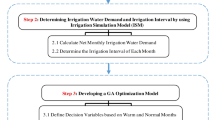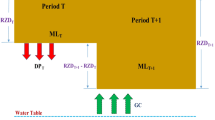Abstract
This paper focuses on irrigation schemes under rotational water supply in arid and semiarid regions. It presents a methodology for developing plans for optimum allocation of land area and water, considering performance measures such as productivity, equity and adequacy. These irrigation schemes are characterized by limited water supply and heterogeneity in soils, crops, climate and water distribution network, etc. The methodology proposed in this paper, therefore, uses a previously developed simulation–optimization model (Area and Water Allocation Model, AWAM) that considers the heterogeneity of the irrigation scheme in the allocation process, and modifies this to take account of equity and adequacy of supply to irrigated areas. The AWAM model has four phases to be executed separately for each set of irrigation interval over the irrigation season: 1. generation of irrigation strategies for each crop–soil–region combination (CSR unit), 2. preparation of irrigation programmes for each irrigation strategy, 3. selection of specified number of irrigation programmes for each CSR unit and 4. optimum allocation of land area and water to different parts of the irrigation scheme (allocation units) for maximizing productivity. In the modified AWAM model, the adequacy is included at Phase-2 (by including only the irrigation programmes for full irrigation of each CSR unit) and equity is included at Phase-4 (by including the constraints for equity). The paper briefly discusses the applicability of the modified AWAM model for a case study of Nazare medium irrigation scheme in Southern India. The results of the case study indicated that the performance measures of productivity, equity and adequacy conflict with each other.



Similar content being viewed by others
References
Abernethy CL (1986) Performance measurement in canal water management: a discussion. ODI–IIMI Irrigation Management Network Paper 86/2d, p 25
Bos MG (1997) Performance indicators for irrigation and drainage. Irrig Drain Syst 11:119–137
English M, Nuss GS (1982) Designing for deficit irrigation. J Irrig Drain Eng 108(IR2):91–106
Gorantiwar SD (1995) A model for planning and operation of heterogeneous irrigation schemes in semi-arid regions under rotational water supply, a PhD thesis, Loughborough University of Technology, Loughborough, Leicestershire, UK
Gorantiwar SD, Smout IK (2003) Allocation of scarce water resources using deficit irrigation in rotational systems. J Irrig Drain Eng 29(3):155–163
Gorantiwar SD, Smout IK (2005) Performance assessment of irrigation water management of heterogeneous irrigation schemes: 1. A framework for evaluation. Irrig Drain Syst 19:1–36
Hargreaves GH, Samani ZA (1984) Economic considerations of deficit irrigation. J Irrig Drain Eng 110(4):343–358
Hennessy J (1993) Water management in the 21st century. In: Proceedings of the 15th congress on irrigation and drainage: water management in the next century held at the Hague, the Netherlands, 1-J, pp 1–31
Irrigation Research Development (1992) Report of pre-irrigation soil Survey of the command of Nazare medium irrigation project, Dist. Pune Irrigation Research Development, Department of Irrigation, Pune, Maharashtra State, India
Keller J, Sivanappan RK, Varadan KM (1992) Design logic for deficit drip irrigation of coconut trees. Irrig Drain Syst 6:1–7
Khepar SD, Gulati HS, Yadav AK, Brar TPS (2000) A model for equitable distribution for canal water. Irrig Sci 19:191–197
Latif M, Sarwar S (1994) Proposal for equitable water allocation for rotational irrigation in Pakistan. Irrig Drain Syst 8:35–48
Mainuddin M, Gupta AD, Onta PR (1996) Optimal crop planning model for an existing groundwater irrigation project in Thailand. Agric Water Manag 33:43–62
Malhotra SP (1982) The warabandi system and its infrastructure. Central Board of Irrigation and Power, New Delhi, India
Mandavi AB (1998) Modernization of irrigation system operational management by way of canal automation in India. In: Modernization of irrigation system operations: proceedings of the 5th ITIS network international meeting, Aurangabad, India, 28–30 October 1998, the food and agriculture organization of the united nations, Regional Office for Asia and the Pacific, Maliwan Mansion, 39 Phra Athit Road Bangkok 10200, Thailand
Matanga GB, Marino MA (1979) Irrigation planning 1. Cropping pattern. Water Resour Res 15(3):672–678
Onta PR, Loof R, Banskota M (1995) Performance based irrigation planning under water shortage. Irrig Drain Syst 9:143–162
Paul S, Panda SN, Nagesh Kumar D (2000) Optimal irrigation allocation: a multilevel approach. J Irrig Drain Eng 126(3):149–156
Pinstrup-Andersen P, Pandya-Lorch R, Rosegrant MW (1997) The world food situation: recent developments, emerging issues, and long-term prospects. Food policy report, International Food Policy Research Institute, Washington, D.C., December 1997, p 36
Sahoo GB, Loof R, Abernethy CL, Kazama S (2001) Reservoir release policy for large irrigation system. J Irrig Drain Eng 127(5):302–310
Shyam R, Chauhan HS, Sharma JS (1994) Optimal operation scheduling model for a canal system. Agric Water Manag 26:213–225
Smout IK, Gorantiwar SD (2005) A multilevel approach for optimizing land and water resources and irrigation deliveries for tertiary units in large irrigation schemes, 1. Method. J Irrig Drain Eng 131(3):254–263
Sritharan SI, Clyma W, Richardson EV (1988) On-farm application system design and project-scale water management. J Irrig Drain Eng 114(4):622–643
Stofkoper J, Tilak MBG (1992) A report on action research program in Nazare medium irrigation project, Maharashtra State. Pune Irrigation Division, Pune, India
Sunantara JD, Ramirez JA (1997) Optimal stochastic multicrop seasonal and intraseasonal irrigation control. J Water Resour Plan Manage 123(1):39–48
Trimmer WL (1990) Applying partial irrigation in Pakistan. J Irrig Drain Eng 116(3):342–353
Vedula S, Mujumdar PP (1992) Optimal reservoir operation for irrigation of multiple crops. Water Resour Res 28(1):1–9
Wardlaw R, Barnes J (1999) Optimal allocation of irrigation water supplies in real time. J Irrig Drain Eng 125(6):345–354
Yaron D, Dinar A (1982) Optimum allocation of farm irrigation water during peak seasons. Am J Agric Econ 64:681–689 (November)
Author information
Authors and Affiliations
Corresponding author
Rights and permissions
About this article
Cite this article
Gorantiwar, S.D., Smout, I.K. Model for performance based land area and water allocation within irrigation schemes. Irrig Drainage Syst 20, 345–360 (2006). https://doi.org/10.1007/s10795-006-9012-0
Received:
Accepted:
Published:
Issue Date:
DOI: https://doi.org/10.1007/s10795-006-9012-0




